Depending on the kind of wood, past wood treatments, exposure to the elements, etc., water-based stains offer varying degrees of coverage and protection. In addition, you should also get experienced in applying water-based stains to the wood for lasting results. But what is the proper way to achieve it?
Sanding your wood is the first stage in preparing it for the water-based stain. You might want 120-grit medium-grade sandpaper. Later, a high grade of up to 220 may be required. Go in a single direction until prepared to take the water-based dye. Keep the brush damp with the stain and move it in long strokes. Recoat after 30 min and wait at least 3 hours for drying.
Have you ever attempted to use a water-based stain, but the coverage was patchy and uneven? If so, continue reading this article by scrolling down. I will provide the guidance you ought to know to achieve an effective result the first time based on my trials with a water-based stain and numerous hours a day working with the stain.
Also Read: Deck VS Curb Mounted Skylight: Differences, Costs, Pros And Cons
How Can I Apply Water-Based Stain?
If you want to refresh old, dull furniture or add inexpensive attractiveness to new, unpainted furniture, water-based stains bring beauty and elegance to the design of your house. Oil-based stains are more difficult to remove with soapy water, whereas water-based stains dry more quickly. Water-based stains offer a clean surface and don’t degrade over time as oil-based ones.
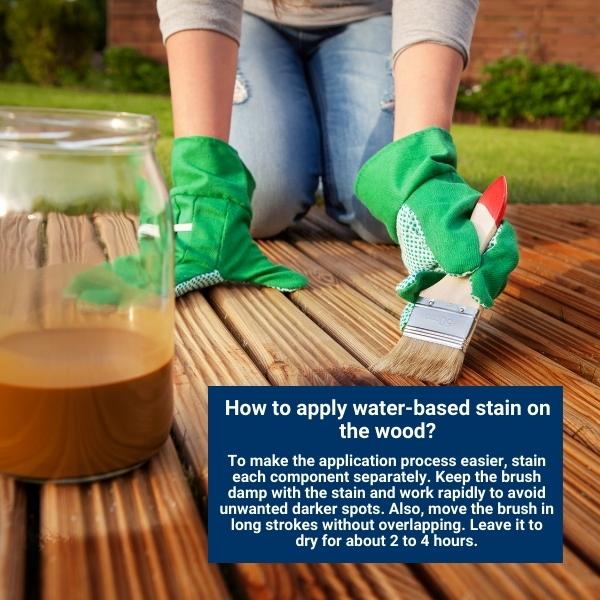
When using water-based stains, the natural wood will rise, requiring specific techniques and treatments to produce a polished appearance. Apply a water-based stain with a foamy or synthetic brush!
Preparation
1. With sanding, you can eliminate dust, oil, and other minor flaws in the wood. Medium-grained sandpaper with a grit range of 120 to 180 should be used to rub the surface while following the grain.
2. Sand wood that has been cut against the grain or with end grains using 240- or 320-grit sandpaper. Higher-grit sandpaper will direct the fibers, preventing more stains from soaking into the grain. End-grains are more permeable and collect more stains than other places.
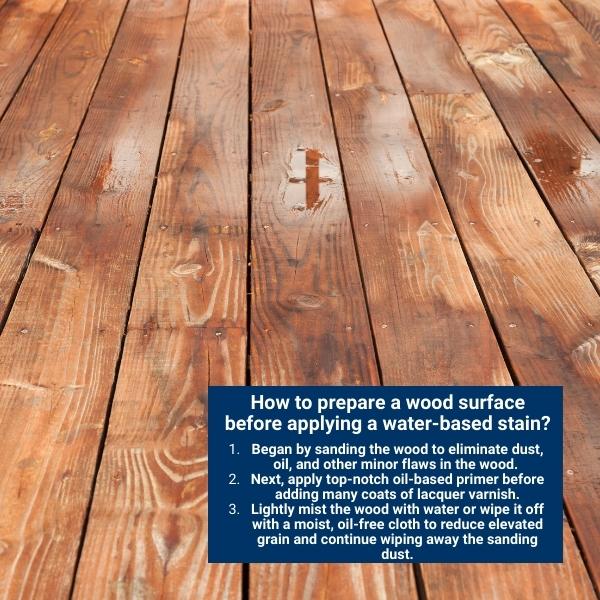
3. Finally, you can paint your wood if you desire. Prior to painting, a sealer must be applied. Check the sealer’s directions to see how long you should wait before painting. Utilize a top-notch oil-based primer before adding many coats of lacquer varnish.
4. Leave the terminal grains and sand all areas with a piece of 220-grit paper, and dust from the wood should be vacuumed.
5. Lightly mist the wood with water or wipe it off with a moist, oil-free cloth to reduce elevated grain. Sand the wood again with 220-grit sandpaper after allowing it to dry completely. With a cleaner or oil-free cloth, clean the sanding dust.
Test
1. To evenly disperse the pigments that have settled, stir the stain mixture using a paintbrush for a few minutes. In the stain, dunk a foam or synthetic brush. Remove any extra on the inside of the can by wiping it off.
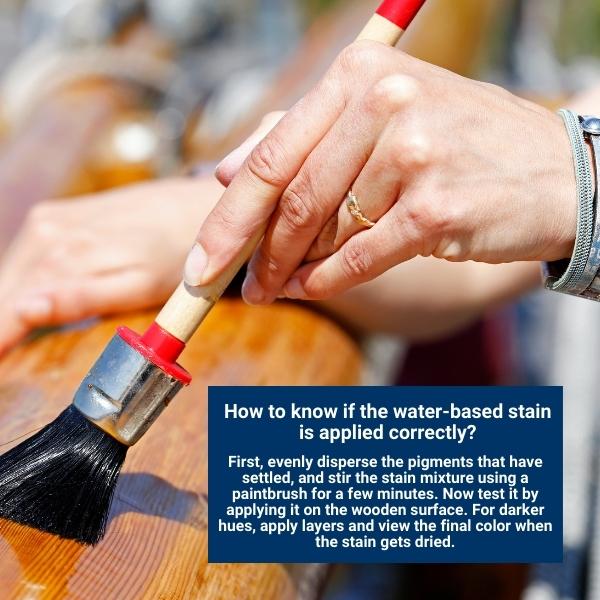
2. Apply a tiny amount of stain to an inconspicuous place to test it, and then wipe it down with a gentle, oil-free cloth. Make sure the color saturation is correct.
3. If the stain isn’t strong enough, add another coat in the testing area. To view the final color, let the stain dry.
Staining
1. Divide the project into many components so stain application gets easier.
2. To load the brush, dip it midway into the container. When applying stain to a wooden surface, keep the brush damp with the stain.
3. Work each area as rapidly as possible to avoid streaks or unwanted darker spots when the stain dries. Ideally, leave the moist stain on the board for no more than two minutes.
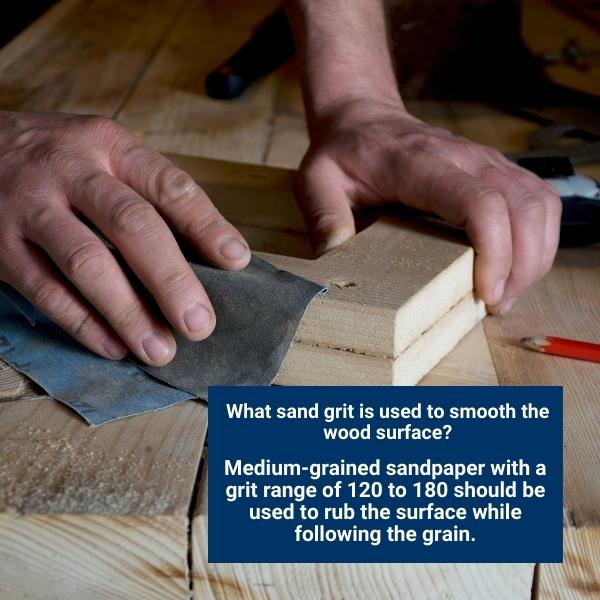
4. Move the brush in long strokes with the grain. Fill in all areas with as little overlap as possible. With the brush, correct any significant drips or evident overlaps right away.
5. To even out the discoloration, rub the area with a gentle, oil-free cloth while working with the grain. After 30 minutes, recoat if required. Give the stain two to four hours to dry.
A Few Important Advantages Of Water-Based Wood Stains
- Water-based stains remain longer, shield the cloth from Ultraviolet radiation, and aid in preserving the original hues.
- It reduces the likelihood that mold, fungus, and mildew will find food sources, increasing the protection provided to the wood by removing its harmful foes.
- Cleaning is incredibly simple, requiring only a mixture of water and soap applied with cloth or brushes.
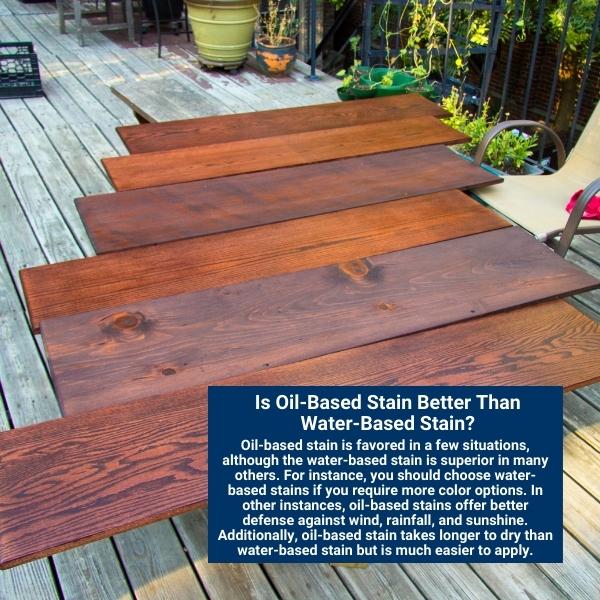
- The remarkable thing about this kind of stain is how quickly it dries. It won’t take more than two hours after staining the deck before you can begin stepping on it.
- Since no moisture will be stored within the wood to destroy it, it is extremely breathable.
- If you have stained your wood with a water-based stain and want to refresh the finish when it becomes worn, you don’t need to remove and sand it. After a quick wash with soap and water, the wood is prepared for subsequent staining.
Conclusion
There are undoubtedly several guidelines that must be observed while using a water-based stain. However, a water-based stain also has advantages. You can stain and varnish on the same day because it dries quickly. A water-based stain has significantly less odor than a conventional oil-based stain if you are allergic to scents.
Additionally, you can easily apply water-based stain due to its breathable property and principal basis formed of water rather than chemicals.
FAQs
Does Water-Based Stain Resist Water?
You should not anticipate rain and water protection from the water-based stain because it is not extremely waterproof. However, you can anticipate some waterproofing if polyurethane sealer is applied. The greatest option for protecting your woodwork against water is an oil-based stain.
How To Determine A Water-Based Stain?
Get some rubbing alcohol and a cotton swab. Wipe the cotton swab on the wood after dipping it in the alcohol. The stain is water-based if the color fades after dribbling the cotton ball dipped in alcohol. Wait for a few minutes to acquire a precise finish, and give the alcohol time to dry. It will allow you to decide more wisely. You can conduct this experiment on a little wood chunk to avoid damaging anything.

